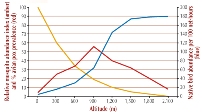
More than half of the endemic bird taxa on the Hawaiian Islands have been driven extinct. For forest birds, the accidental introduction of mosquitoes bringing diseases has had devastating consequences, limiting their abundance and distribution and playing a part in local extinctions.

The Hawaiian islands once supported 109 endemic bird species, but 68% of these have gone extinct since the arrival of humans mainly as a result of habitat loss, introduced predators and disease (Olson and James 1982; Reed et al. 2012). Of the remaining species, 32 are listed as globally threatened, which accounts for 25% of all globally threatened bird species in the United States.
For forest-dwelling native birds, the accidental introduction of mosquitoes Culex quinqufasciatus has been particularly devastating. Diseases transmitted by mosquitoes, such as avian malaria Plasmodium relictum and avian pox Poxvirus avium, reduce habitat availability by limiting the range of most forest birds to elevations above 1500 meters, where mosquitos are absent because of cool temperatures (van Riper and Scott 2001; Jarvi et al. 2001; LaPointe et al. 2009; Samuel et al. 2011).
The prevalence of pox in Elepaio Chasiempis sandwichensis, for example, is inversely related to the population density of this and other native bird species, (VanderWerf 2001). The highest incidence of malaria and pox thus occurs in wet, mid-elevation forests where mosquitoes overlap with highly susceptible native birds (van Riper et al. 2002, see figure). However, climate change is predicted to exacerbate existing stressors to Hawaii’s forest birds through increased disease transmission (Atkinson et al. 2014)
Other invasive species are also limiting the distribution of birds. Species such as the Critically Endangered Akekee Loxops caeruleirostris and Akikiki Oreomystis bairdi have lower level of occupancy in areas dominated by invasive plants (e.g. stawberry guava Psidium cattleianum) and feral ungulates (e.g. feral pigs Sus scrofa) (Behnke et al. 2016). The current range of the Endangered Oahu Elepaio Chasiempis ibidis has declined by 75% since 1975 (VanderWerf et al. 2013), primarliy as a result of nest predation by alien black rats Rattus rattus and avian pox (Vanderwerf 2009).
Related Case Studies in other sections
Related Species
References
Compiled: 2004 Last updated: 2017
Recommended Citation:
BirdLife International (2017)
Native forest birds in the Hawaiian Islands are limited by introduced avian diseases .
Downloaded from https://datazone.birdlife.org/sowb/casestudy/native-forest-birds-in-the-hawaiian-islands-are-limited-by-introduced-avian-diseases- on 22/12/2024